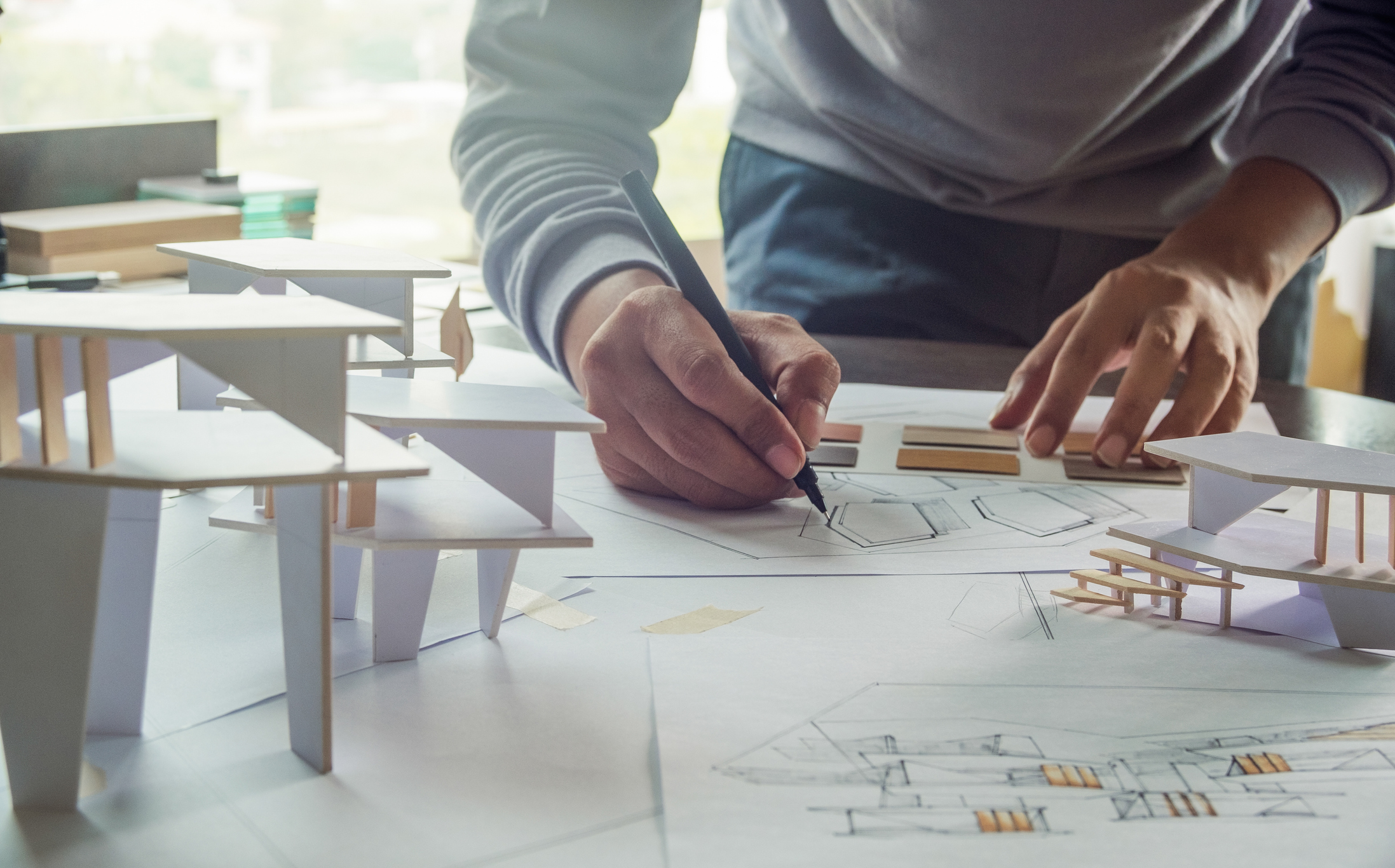Architect Insights on Balancing Form and Function
Architect Insights on Balancing Form and Function
Blog Article
Understanding the Diverse Job Paths Available for Aspiring Architect
As an aspiring Architect, you have a world of career paths waiting for you. Whether you're attracted to traditional style or the subtleties of sustainable layout, there's a particular niche that aligns with your passions.
Conventional Architecture: Designing Buildings and Structures
Traditional design concentrates on creating structures and structures that blend performance with visual appeal. Your layouts can reflect social heritage, showcasing regional customs while satisfying modern-day requirements.
You'll establish skills in preparing, model-making, and site analysis, permitting you to imagine and communicate your ideas successfully. Involving with clients, you'll need to comprehend their vision and equate it right into practical layouts.
Furthermore, building codes and sustainability practices are vital in your job, guaranteeing your frameworks are ecologically friendly and secure. As you expand in your occupation, you'll locate opportunities in domestic, business, and even repair projects, each offering distinct difficulties. Accepting conventional design leads the means for a satisfying profession that pays homage to the past while forming the future.
Urban Planning: Shaping Neighborhoods and Public Spaces
As a hopeful Architect, you can play an important duty as a city coordinator, changing just how communities engage and function. By employing neighborhood interaction techniques, you'll guarantee that locals have a voice in shaping their environment. And also, incorporating lasting style principles will help produce rooms that not only satisfy today's needs but likewise safeguard the future.
Function of Urban Planners
While lots of could think of engineers as the single enthusiasts behind structures, urban organizers play a vital duty in forming the broader landscape of neighborhoods and public spaces. By teaming up with numerous stakeholders, you'll aid make parks, transport systems, and residential areas that promote social interaction and availability. Your knowledge in spatial design and community dynamics enables you to picture future growth while maintaining cultural heritage.
Area Engagement Strategies
Effective neighborhood involvement techniques are crucial for urban coordinators to ensure that the voices of homeowners are heard and valued in the planning procedure. To cultivate significant dialogue, you ought to focus on open online forums and workshops where community participants can share their concepts and issues. By actively incorporating and listening responses, you'll create spaces that mirror the area's demands, eventually leading to more successful and sustainable city environments.
Lasting Layout Principles
When creating urban areas, including sustainable design concepts is crucial for creating atmospheres that flourish both ecologically and socially. You need to start by concentrating on energy efficiency, making use of products that decrease waste and promote recycling. Take into consideration incorporating environment-friendly spaces, like parks and yards, to boost biodiversity and boost air top quality. Promoting walkability and public transport can minimize reliance on cars, cultivating a much healthier neighborhood.
Designing with water conservation in mind is additionally essential-- think regarding rainfall yards and absorptive surfaces to handle stormwater. Involving community members during the planning procedure warranties that the rooms you create satisfy their demands and encourage social communication. By embracing these principles, you'll add to vibrant, lasting city landscapes that profit every person.

Landscape Style: Producing Sustainable Outside Atmospheres
As you check out landscape architecture, you'll discover crucial layout principles that produce useful and attractive outdoor rooms. Lasting practices play an important role in making sure these settings flourish while decreasing ecological influence. Plus, you'll discover a range of occupation chances that enable you to make a genuine distinction in just how people connect with nature.
Design Principles in Landscape
Understanding layout principles in landscape architecture is crucial for developing sustainable outdoor settings that integrate with nature. You'll require to consider elements like percentage, balance, and range to assure your designs really feel cohesive and welcoming. Furthermore, pay focus to seasonal modifications, making with materials that complement the surroundings year-round.
Lasting Practices Review
Sustainable techniques in landscape architecture not just focus on visual appeals but likewise prioritize ecological health and resource conservation. By integrating indigenous plants, you boost biodiversity and minimize the requirement for chemical fertilizers and pesticides. Carrying out effective watering systems assists preserve water and decreases runoff, safeguarding close-by environments. You can design spaces that advertise dirt health, such as using organic products and practicing permaculture principles. Furthermore, incorporating eco-friendly framework, like rainfall gardens and porous sidewalks, help in stormwater monitoring and reduces city heat. You contribute to a healthier earth and supply rooms that foster neighborhood connection when you create exterior atmospheres with sustainability in mind. Inevitably, these methods ensure your designs benefit both people and the environment for many years to find.
Profession Opportunities Expedition
With a strong structure in lasting methods, landscape style uses a variety of occupation courses that allow you to make a significant influence on the setting. You can function as a landscape developer, creating cosmetically pleasing and useful outside rooms, or focus on environmental repair, aiding to restore damaged communities. Urban organizers often team up with landscape engineers to produce green areas in city setups, enhancing city livability. If you're passionate about education and learning, think about coming to be a landscape design educator, inspiring future generations. Furthermore, you might deal with nonprofits focused on ecological sustainability or take part in research study to introduce new techniques. Each course not just shapes attractive atmospheres but also promotes a much healthier world for future generations.
Sustainable Layout: Focusing on Eco-Friendly Practices
As you explore your occupation in style, welcoming green techniques can set you apart in a competitive area. Lasting layout focuses on creating buildings that lessen ecological impact while enhancing occupant well-being. By integrating sustainable products, energy-efficient systems, and sustainable building methods, you'll add to a greener future.
Begin by gaining knowledge of environment-friendly qualifications like LEED or BREEAM, which can reinforce your credentials. Think about just how all-natural light, ventilation, and thermal performance can optimize design. Work together with designers and ecological experts to innovate services that decrease waste and conserve sources.
Do not fail to remember the importance of area involvement-- interesting local stakeholders can influence styles that harmonize with the atmosphere. As clients significantly focus on sustainability, your expertise in environment-friendly techniques will not just bring in tasks but likewise meet your interest for responsible design. Welcome this important aspect of the career, and view your occupation prosper.
Historical Preservation: Shielding and Bring Back Social Heritage
While you start on your architectural journey, take into consideration the crucial role of historical preservation in maintaining our cultural heritage. This area concentrates on the protection and remediation of significant structures, sites, and frameworks that inform the stories of our past. By taking part in historical preservation, you'll assist secure the building heritage that forms her comment is here neighborhood identity.
As a historical preservation Architect, you'll assess historic significance and analyze the condition of structures. You'll function carefully with chroniclers and guardians to assure genuine restoration strategies are utilized. This occupation course enables you to mix creative thinking with study, allowing you to make solutions that appreciate initial products and workmanship.
Your job not only adds to sustainability by recycling existing buildings but additionally fosters a sense of pride within communities. Embracing this path will certainly aid you end up being a guardian of history, protecting the stories and aesthetics that enrich our lives.
Inside Design: Enhancing Indoor Spaces
Historic preservation and interior design both share a dedication to improving the built setting, however they focus on various facets. While historic preservation highlights keeping a framework's cultural and historic worth, interior design nos in on enhancing indoor spaces for capability and visual appeals.
As a hopeful Architect, you'll locate that interior architecture enables you to mix imagination with technological skills. You'll make rooms that not just look excellent yet additionally advertise convenience and efficiency. This field involves recognizing just how light, color, and products connect within an area, influencing mood link and use.
You'll deal with numerous projects, from property homes to commercial workplaces, making sure that each setting fulfills the demands of its passengers. By focusing on individual experience, you can transform interiors into practical and inspiring spaces, making a significant effect on exactly how individuals interact with their surroundings. Embrace the possibility to improve interior environments and form the way individuals function and live.
Industrial Layout: Merging Capability With Aesthetic Appeals
Commercial design plays an essential duty in creating products that effortlessly blend visual appeals with performance, making sure that what you make use of day-to-day is not just aesthetically enticing however additionally practical. As an ambitious Architect, you can involve yourself in this area, concentrating on developing everything from furnishings to customer electronic devices. Your job entails recognizing user requirements, materials, and manufacturing processes, enabling you to produce innovative solutions that boost everyday experiences.
In industrial design, you'll typically work together with designers, marketers, and suppliers, guaranteeing that your layouts are not only attractive however also feasible. You'll discover to stabilize kind and function, prioritizing functionality without sacrificing style. By sharpening your skills in laying out, 3D modeling, and prototyping, you'll be well-appointed to bring your ideas to life. This job path provides a dynamic environment where imagination fulfills functionality, making it a satisfying choice for engineers curious about forming the items of tomorrow.
Often Asked Questions
What Educational Qualifications Do I Required to Come To Be an Architect?
To come to be an engineer, you'll need an expert level in architecture, normally a Bachelor's or Master's. In addition, you'll have to finish a teaching fellowship and pass the Architect Registration Exam to exercise lawfully.
Are There Certification Requirements for Various Building Career Paths?
Yes, there're accreditation demands for various building courses. Architect. You'll need to pass tests, complete internships, and often go after specialized training, depending upon your picked emphasis, like landscape style, city layout, or historical preservation
What Software Skills Are Crucial for Engineers Today?

Just How Can I Gain Practical Experience While Studying Style?
You can go to my blog gain functional experience by interning at architectural firms, participating in layout competitions, offering for community jobs, or working together with classmates on real-world tasks. These opportunities improve your abilities and construct beneficial connections in the market.
What Job Opportunities Exist Outside Standard Architecture Firms?
You can check out different work opportunities outside traditional design companies, like metropolitan planning, interior layout, landscape design, building and construction monitoring, realty advancement, or also roles in sustainability consulting. Each deals special challenges and rewards.
Whether you're drawn to conventional style or the nuances of lasting layout, there's a particular niche that lines up with your rate of interests.When making city areas, including sustainable style principles is critical for creating environments that flourish both environmentally and socially.As you discover landscape architecture, you'll find essential layout principles that develop functional and attractive outdoor rooms.Recognizing style principles in landscape style is necessary for developing sustainable exterior environments that integrate with nature.In industrial style, you'll typically collaborate with marketers, suppliers, and engineers, ensuring that your designs are not only gorgeous but also feasible.
Report this page